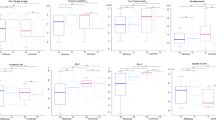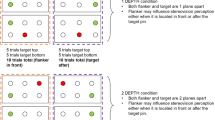Abstract
Purpose
The purpose of this study was to investigate the benefits of vision training with visual evoked potentials (VEP) biofeedback in amblyopia after the critical period in 8 to 17-year (11.5 ± 3.1) old children.
Methods
Ten participants with monocular amblyopia after the critical period underwent a 10-week, 20-session vision training program with the Retimax Vision Trainer device. During each session, the participants were instructed to be as focused as possible onto the fixation point in the middle of the screen. The size of the fixation point and the pitch of the background sound were changing according to VEP parameters and thus provided the participants real-time feedback of their visual performance.
Results
The mean BCVA improvement across our group was 0.12 LogMAR (p < 0.01). There was also a significant increase in contrast sensitivity to the FACT chart across all spatial frequencies (all p < 0.05). Electrophysiologic data revealed higher steady-state visual evoked potentials (SS-VEP) amplitudes and correspondingly lower fixation point values in the last 2 weeks of training compared to the first 2 weeks (both p < 0.01). Due to unexplainably low VEP amplitude levels in later trainings compared to those in the beginning in two participants, we have not found a significant correlation between the increase in BCVA and the increase in SS-VEP amplitude (p = 0.88). At the follow-up at 2 and 12 months following the end of training, both BCVA and contrast sensitivity remained within the levels achieved at the end of training. In some participants, however, no improvement of BCVA was observed.
Conclusions
The tested vision training approach demonstrates modest but stable improvement of psychophysical parameters as well as objective characteristics in amblyopia after the critical period. Real-time SS-VEP can be used as an objective parameter to monitor participants’ attention during vision training stimulation.





Similar content being viewed by others
References
Astle AT, Webb BS, Mcgraw PV (2011) Can perceptual learning be used to treat amblyopia beyond the critical period of visual development? Ophthalmic Physiol Opt 31:564–573
Simons K (2005) Amblyopia characterization, treatment, and prophylaxis. Surv Ophthalmol 50:123–166
Tailor V, Bossi M, Greenwood JA, Dahlmann-Noor A (2016) Childhood amblyopia: current management and new trends. Br Med Bull 119:75–86
Daw N (1998) Critical periods and amblyopia. Arch Ophthalmol 116:502–505
Wiesel TN, Hubel DH (1963) Single-cell responses in striate cortex of kittens deprived of vision in one eye. J Neurophysiol 26:1003–1017
Hess RF, Thompson B (2015) Amblyopia and the binocular approach to its therapy. Vision Res 114:4–16
Suttle CM (2010) Active treatments for amblyopia: a review of the methods and evidence base. Clin Exp Optom 93:287–299
Levi DM, Li RW (2009) Improving the performance of the amblyopic visual system. Philos Trans R Soc Lond B Biol Sci 364:399–407
Bavelier D, Levi DM, Li RW, Dan Y, Hensch TK (2010) Removing brakes on adult brain plasticity: from molecular to behavioral interventions. J Neurosci 30:14964–14971
Chen PL, Chen JT, Fu JJ, Chien KH, Lu DW (2008) A pilot study of anisometropic amblyopia improved in adults and children by perceptual learning: an alternative treatment to patching. Ophthalmic Physiol Opt 28:422–428
Chen Z, Li J, Liu J, Cai X, Yuan J, Deng D, Yu M (2016) Monocular perceptual learning of contrast detection facilitates binocular combination in adults with anisometropic amblyopia. Sci Rep 6:20187
Levi DM, Polat U (1996) Neural plasticity in adults with amblyopia. Proc Natl Acad Sci USA 93:6830–6834
Li RW, Young KG, Hoenig P, Levi DM (2005) Perceptual learning improves visual performance in juvenile amblyopia. Invest Ophthalmol Vis Sci 46:3161–3168
Polat U, Ma-Naim T, Belkin M, Sagi D (2004) Improving vision in adult amblyopia by perceptual learning. Proc Natl Acad Sci USA 101:6692–6697
Tsirlin I, Colpa L, Goltz HC, Wong AMF (2015) Behavioral training as new treatment for adult amblyopia: a meta-analysis and systematic review. Invest Ophthalmol Vis Sci 56:4061–4075
Zhou Y, Huang C, Xu P, Tao L, Qiu Z, Li X, Lu ZL (2006) Perceptual learning improves contrast sensitivity and visual acuity in adults with anisometropic amblyopia. Vision Res 46:739–750
Yalcin E, Balci O (2014) Efficacy of perceptual vision therapy in enhancing visual acuity and contrast sensitivity function in adult hypermetropic anisometropic amblyopia. Clin Ophthalmol 8:49–53
Levi DM, Li RW (2009) Perceptual learning as a potential treatment for amblyopia: a mini-review. Vis Res 49:2535–2549
Norcia AM, Appelbaum LG, Ales JM, Cottereau BR, Rossion B (2015) The steady-state visual evoked potential in vision research: a review. J Vis 15:4
Vialatte FB, Maurice M, Dauwels J, Cichocki A (2010) Steady-state visually evoked potentials: focus on essential paradigms and future perspectives. Prog Neurobiol 90:418–438
Hillyard SA, Anllo-Vento L (1998) Event-related brain potentials in the study of visual selective attention. Proc Natl Acad Sci USA 95:781–787
Lee YC, Lin WC, Cherng FY, Ko LW (2016) A visual attention monitor based on steady-state visual evoked potential. IEEE Trans Neural Syst Rehabil Eng 24:399–408
Esposito Veneruso P, Ziccardi L, Magli G, Falsini B, Magli A (2014) Short-term effects of vision trainer rehabilitation in patients affected by anisometropic amblyopia: electrofunctional evaluation. Doc Ophthalmol 129:177–189
Odom JV, Bach M, Brigell M, Holder GE, McCulloch DL, Mizota A et al (2016) ISCEV standard for clinical visual evoked potentials: (2016 update). Doc Ophthalmol 133:1–9
Rosser DA, Cousens SN, Murdoch IE, Fitzke FW, Laidlaw DA (2003) How sensitive to clinical change are ETDRS logMAR visual acuity measurements? Invest Ophthalmol Vis Sci 44:3278–3281
Heinrich SP, Krüger K, Bach M (2011) The dynamics of practice effects in an optotype acuity task. Graefes Arch Clin Exp Ophthalmol 249:1319–1326
Vanden Bosch ME, Wall M (1997) Visual acuity scored by the letter-by-letter or probit methods has lower retest variability than the line assignment method. Eye (Lond) 11:411–417
Polat U, Ma-Naim T, Spierer A (2009) Treatment of children with amblyopia by perceptual learning. Vis Res 49:2599–2603
Wang G, Zhao C, Ding Q, Wang P (2017) An assessment of the contrast sensitivity in patients with ametropic and anisometropic amblyopia in achieving the corrected visual acuity of 1.0. Sci Rep 7:42043
Abrahamsson M, Sjöstrand J (1988) Contrast sensitivity and acuity relationship in strabismic and anisometropic amblyopia. Br J Ophthalmol 72:44–49
Koskela PU, Alanko HI (1990) Correlations between visual acuity, grating acuity and contrast sensitivity in amblyopia. Acta Ophthalmol (Copenh) 68:91–93
Moseley MJ, Stewart CE, Fielder AR, Stephens DA (2006) Intermediate spatial frequency letter contrast sensitivity: its relation to visual resolution before and during amblyopia treatment. Ophthalmic Physiol Opt 26:1–4
Levi DM (2005) Perceptual learning in adults with amblyopia: a reevaluation of critical periods in human vision. Dev Psychobiol 46:222–232
McKee SP, Levi DM, Movshon JA (2003) The pattern of visual deficits in amblyopia. J Vis 3:380–405
Oken BS, Salinsky MC, Elsas SM (2006) Vigilance, alertness, or sustained attention: physiological basis and measurement. Clin Neurophysiol 117:1885–1901
Acknowledgments
The preliminary account of this work was presented at European Neuro-Ophthalmology Society (EUNOS) 2017 meeting, where the poster was selected as the Best EUNOS Young Neuro-Ophthalmologist In-Training Presentation. We would like to thank Claudio Baglini and the company CSO, Florence, Italy for upgrading the Retimax Vison Trainer according to our requirements and for the technical support. We would also like to thank Joseph A. Breuer for language editing assistance.
Funding
This research was supported by the Slovenian Research Agency (ARRS) Grant P3-0333.
Author information
Authors and Affiliations
Corresponding authors
Ethics declarations
Statement of human rights
All research procedures performed in the study followed the tenets of The Declaration of Helsinki and The Slovenian medical deontology codex. The study was approved by the committee for Medical Research Ethics of Slovenia (file number: 0120-678/2015-2, date: 15. 12. 2015).
Informed consent
Informed consent with explanation was obtained from the parents of the children participating in the study.
Conflict of interest
The authors declare that they have no conflict of interest.
Additional information
Publisher's Note
Springer Nature remains neutral with regard to jurisdictional claims in published maps and institutional affiliations.
Rights and permissions
About this article
Cite this article
Lapajne, L., Roškar, S., Tekavčič Pompe, M. et al. Vision training with VEP biofeedback in amblyopia after the critical period. Doc Ophthalmol 141, 269–278 (2020). https://doi.org/10.1007/s10633-020-09774-z
Received:
Accepted:
Published:
Issue Date:
DOI: https://doi.org/10.1007/s10633-020-09774-z




